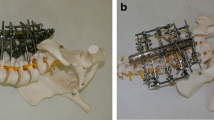Abstract
Objective
The description of the operation technique and retrospective review of 15 consecutive patients who were treated by posterior sacral dome resection and single-stage reduction with pedicle screw fixation for high-grade, high-dysplastic spondylolisthesis.
Materials and methods
All the patients had high-grade, high-dysplatic spondylolisthesis L5 and were treated by posterior sacral dome resection and posterior single-stage reduction from L4–S1. The average age at the time of surgery was 17.3 (11–28) years. The average follow-up time is 5.5 (2–11.6) years. Clinical and radiologica data were retrospectively reviewed.
Results
Spondylolisthesis was reduced from average 99% preoperative to 29% at the last follow-up. L5 incidence improved from 74° to 56°, the lumbosacral angle improved from 15° kyphosis to 6° lordosis, lumbar lordosis decreased from 69° to 53° from preoperative to the last follow-up. While pelvic incidence of 77° remained unchanged, sacral slope decreased from 51° to 46° and pelvic tilt increased from 25° to 30°. Clinical outcome was subjectively rated to be much better than before surgery by 14 out of 15 patients. Four out of 15 patients had temporary sensory impairment of the L5 nerve root which resolved completely within 12 weeks. There were no permanent neurological complications or no pseudarthrosis.
Conclusion
The sacral dome resection is a shortening osteotomy of the lumbosacral spine which allows a single-stage reduction of L5 without lengthening of lumbosacral region in high-grade spondylolisthesis, which helps to avoid neurological complications. This is a safe surgical technique resulting in a good multidimensional deformity correction and restoration of spino-pelvic alignment towards normal values with a satisfactory clinical outcome.





Similar content being viewed by others
References
Bohlman HH, Cook SS (1982) One-stage decompression and posterolateral and interbody fusion for lumbosacral spondyloptosis through a posterior approach. Report of two cases. J Bone Joint Surg Am 64(3):415–418
Bradford DS, Gotfried Y (1987) Staged salvage reconstruction of grade-iv and v spondylolisthesis. J Bone Joint Surg Am 69(2):191–202
Bradford DS, Boachie-Adjei O (1990) Treatment of severe spondylolisthesis by anterior and posterior reduction and stabilization. A long-term follow-up study. J Bone Joint Surg Am 72(7):1060–1066
DeWald RL, Faut MM, Taddonio RF, Neuwirth MG (1981) Severe lumbosacral spondylolisthesis in adolescents and children. Reduction and staged circumferential fusion. J Bone Joint Surg Am 63(4):619–626
Duval-Beaupere G, Schmidt C, Cosson P (1992) A barycentremetric study of the sagittal shape of spine and pelvis: The conditions required for an economic standing position. Ann Biomed Eng 20(4):451–462
Frennered AK, Danielson BI, Nachemson AL, Nordwall AB (1991) Midterm follow-up of young patients fused in situ for spondylolisthesis. Spine (Phila Pa 1976) 16(4):409–416
Gaines RW, Nichols WK (1985) Treatment of spondyloptosis by two stage l5 vertebrectomy and reduction of l4 onto s1. Spine (Phila Pa 1976) 10(7):680–686
Hanson DS, Bridwell KH, Rhee JM, Lenke LG (2002) Correlation of pelvic incidence with low- and high-grade isthmic spondylolisthesis. Spine (Phila Pa 1976) 27(18):2026–2029
Hresko MT, Labelle H, Roussouly P, Berthonnaud E (2007) Classification of high-grade spondylolistheses based on pelvic version and spine balance: Possible rationale for reduction. Spine (Phila Pa 1976) 32(20):2208–2213
Labelle H, Roussouly P, Berthonnaud E, Transfeldt E, O’Brien M, Chopin D, Hresko T, Dimnet J (2004) Spondylolisthesis, pelvic incidence, and spinopelvic balance: A correlation study. Spine (Phila Pa 1976) 29(18):2049–2054
Labelle H, Roussouly P, Berthonnaud E, Dimnet J, O’Brien M (2005) The importance of spino-pelvic balance in l5–s1 developmental spondylolisthesis: A review of pertinent radiologic measurements. Spine (Phila Pa 1976) 30(6 Suppl):S27–S34
Labelle H, Roussouly P, Chopin D, Berthonnaud E, Hresko T, O’Brien M (2008) Spino-pelvic alignment after surgical correction for developmental spondylolisthesis. Eur Spine J 17(9):1170–1176. doi:10.1007/s00586-008-0713-y
Lamartina C, Zavatsky JM, Petruzzi M, Specchia N (2009) Novel concepts in the evaluation and treatment of high-dysplastic spondylolisthesis. Eur Spine J 18(Suppl 1):133–142
Lamberg T, Remes V, Helenius I, Schlenzka D, Seitsalo S, Poussa M (2007) Uninstrumented in situ fusion for high-grade childhood and adolescent isthmic spondylolisthesis: Long-term outcome. J Bone Joint Surg Am 89(3):512–518
Legaye J, Duval-Beaupere G, Hecquet J, Marty C (1998) Pelvic incidence: A fundamental pelvic parameter for three-dimensional regulation of spinal sagittal curves. Eur Spine J 7(2):99–103
Marchetti PG, Bartolozzi P (1997) Classification of spondylolisthesis as a guideline for treatment. In: Bridwell KH, DeWald RL (eds) The textbook of spinal surgery. 2nd edn. Lippincott-Raven Philadelphia, pp 1211–1254
Muschik M, Zippel H, Perka C (1997) Surgical management of severe spondylolisthesis in children and adolescents. Anterior fusion in situ versus anterior spondylodesis with posterior transpedicular instrumentation and reduction. Spine (Phila Pa 1976) 22(17):2036–2042
Newton PO, Johnston CE 2nd (1997) Analysis and treatment of poor outcomes following in situ arthrodesis in adolescent spondylolisthesis. J Pediatr Orthop 17(6):754–761
O’Brien JP, Mehdian H, Jaffray D (1994) Reduction of severe lumbosacral spondylolisthesis. A report of 22 cases with a ten-year follow-up period. Clin Orthop Relat Res 300:64–69
Petraco DM, Spivak JM, Cappadona JG, Kummer FJ, Neuwirth MG (1996) An anatomic evaluation of l5 nerve stretch in spondylolisthesis reduction. Spine (Phila Pa 1976) 21(10):1133–1138
Shufflebarger HL, Geck MJ (2005) High-grade isthmic dysplastic spondylolisthesis: Monosegmental surgical treatment. Spine (Phila Pa 1976) 30(6 Suppl):S42–S48
Smith MD, Bohlman HH (1990) Spondylolisthesis treated by a single-stage operation combining decompression with in situ posterolateral and anterior fusion. An analysis of eleven patients who had long-term follow-up. J Bone Joint Surg Am 72(3):415–421
Conflict of interest
None.
Author information
Authors and Affiliations
Corresponding author
Rights and permissions
About this article
Cite this article
Min, K., Liebscher, T. & Rothenfluh, D. Sacral dome resection and single-stage posterior reduction in the treatment of high-grade high dysplastic spondylolisthesis in adolescents and young adults. Eur Spine J 21 (Suppl 6), 785–791 (2012). https://doi.org/10.1007/s00586-011-1949-5
Received:
Accepted:
Published:
Issue Date:
DOI: https://doi.org/10.1007/s00586-011-1949-5




